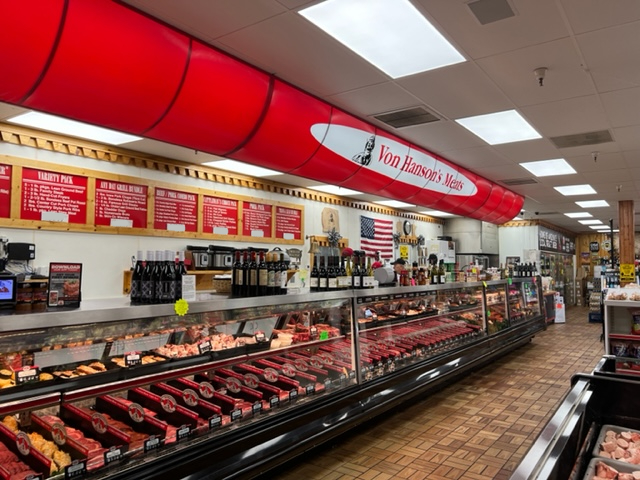Uncover the Art of the Butcher's Cut in a Modern Meat Market
In the ever-evolving landscape of modern meat markets, the butcher's cut has actually transcended its typical origins, merging age-old craftsmanship with contemporary techniques. What genuinely establishes the contemporary butcher apart is their capability to forge a much deeper connection between consumers and the beginnings of their meat.
Evolution of Butchery Strategies
The evolution of butchery strategies shows a rich tapestry of advancement and adaptation driven by advancements in innovation, changes in customer demand, and a much deeper understanding of meat scientific research. Historically, butchery was a craft passed down via generations, with techniques sharpened over centuries to take full advantage of return and flavor. The industrial transformation ushered in automation, transforming standard practices and allowing massive handling.
The mid-20th century saw butchery techniques even more fine-tuned by clinical insights into muscle mass biology and meat aging, boosting both inflammation and taste. Technologies like vacuum packaging and refrigeration prolonged product shelf-life, enabling butchers to expand offerings and improve high quality control. This period likewise noted the surge of customized equipment, such as band saws and meat slicers, which enhanced accuracy and effectiveness in meat handling.

The 21st century has introduced digital innovation right into the butchery world. Electronic systems currently help in tracking animal provenance and enhancing cuts to satisfy particular client choices. In addition, a resurgence in artisanal butchery has emerged, blending traditional skills with modern expertise to provide to customers seeking moral and lasting meat choices. This evolution underscores a vibrant interaction between custom and development, meeting modern needs while protecting the craft's heritage.
Comprehending Meat Cuts
Understanding the details of meat cuts is important for both butchers and customers seeking high quality and worth. For butchers, precise cuts show ability and regard for the craft, guaranteeing marginal waste and optimal yield.

Recognizing muscular tissue make-up is critical; muscles used extra regularly by the animal tend to be harder and are best fit for sluggish cooking approaches, while less-used muscle mass, like those found in the loin, are extra tender and suitable for grilling or roasting. Experience with these differences equips customers to make educated choices, improving their cooking ventures.
Selecting Top Quality Meat
Choosing the appropriate meat includes more than just selecting a visually enticing piece from the display screen. bagley farms meat market edwardsville il. The art of choosing top quality meat needs a critical eye and understanding of details qualities that signify quality and excellence. Pay focus to the color; beef needs to have a bright, cherry-red color, while lamb should display a soft pink tone, and pork a light pink. This indicates the meat is fresh and hasn't been revealed to oxygen for as well lengthy.
Second of all, consider the marbling, which refers to the white flecks of fat within the muscle mass. Appropriate marbling is a vital indication of tenderness and flavor, as it thaws throughout food preparation, enhancing the meat's juiciness. Remember, higher marbling commonly associates with premium quality cuts, such as USDA Prime.
Texture is one more important link essential factor; meat ought to feel solid to the touch, not slimy or overly soft. Additionally, bear in mind the scent. Fresh meat should have a clean, neutral smell, without any sour or off-putting odors.
Pairing Cuts With Food Preparation Approaches

Alternatively, tougher cuts like brisket and chuck roast are rich in collagen, which breaks down right into jelly when cooked slowly. These cuts are suitable for braising or slow-moving roasting, allowing the meat to tenderize gradually and create deep, complex tastes. In a similar way, cuts such as brief ribs and pork shoulder fare well with slow-cooking techniques, where prolonged cooking times change try these out their durable appearances right into delicious dishes.
Lamb shanks and oxtail, which require extended cooking to tenderize, are ideal prospects for stewing or slow simmering. These techniques coax out abundant, hearty tastes while preserving wetness. By comprehending the one-of-a-kind characteristics of each cut, cooks and home cooks alike can elevate their culinary creations, guaranteeing each dish is both satisfying and memorable.
The Butcher's Duty Today
Navigating the developing landscape of the modern meat market, the butcher's function today extends past simple preparation of cuts. Contemporary butchers are cooking artisans, instructors, and advocates for sustainable methods. They bridge the void between the ranch and the fork by making sure ethical sourcing, recognizing animal husbandry, and focusing on transparency in the supply chain. This change reflects the expanding consumer need for quality over amount, where provenance and animal well-being are critical.
Along with crafting exact cuts, butchers now involve directly with clients, offering cooking recommendations and tailoring choices to match individual requirements and preferences. Their expertise in meat aging, marbling, and taste accounts empowers consumers to make enlightened choices, improving their cooking experiences. This customized solution exemplifies the butcher's progressing role site as a trusted consultant in the kitchen.
Furthermore, butchers are crucial in minimizing waste, using entire pets to develop diverse products such as sausages and stocks. This detailed strategy not only respects the animal however additionally aligns with contemporary sustainability goals. By doing this, the modern-day butcher personifies both tradition and development, adapting to an ever-changing market while protecting the creativity and stability of their craft.
Verdict
Proficiency in comprehending diverse meat cuts and quality signs encourages butchers to offer informed referrals, lining up particular cuts with optimal food preparation techniques. By honoring historic methods while embracing modern demands, the butcher's role continues to be important in today's sophisticated meat market.
Comments on “Get the very best Offers on Fresh Meat at Bagley Farms Meat Market Edwardsville IL”